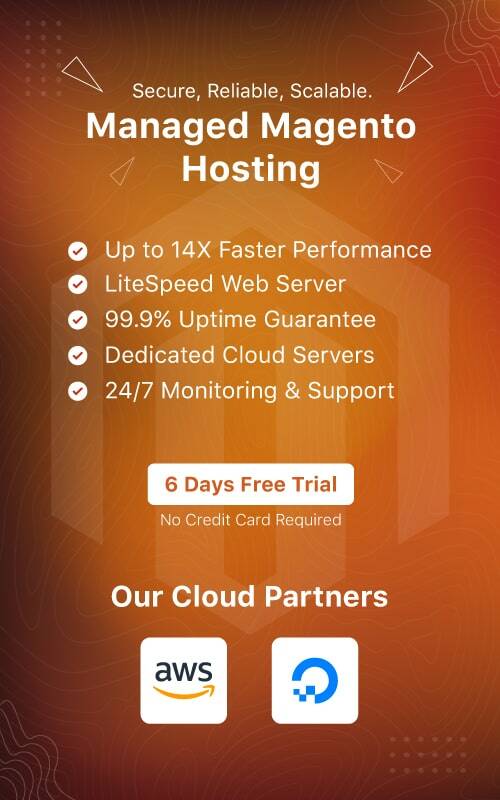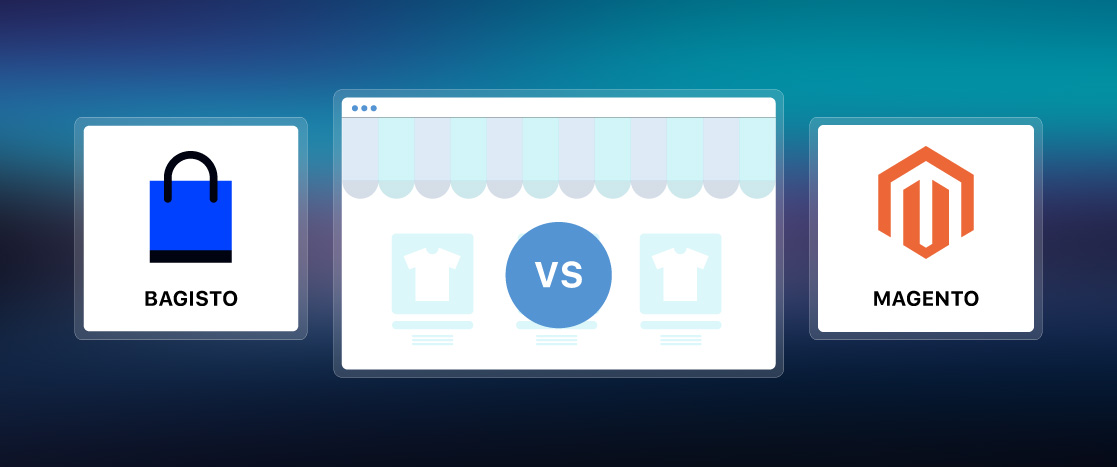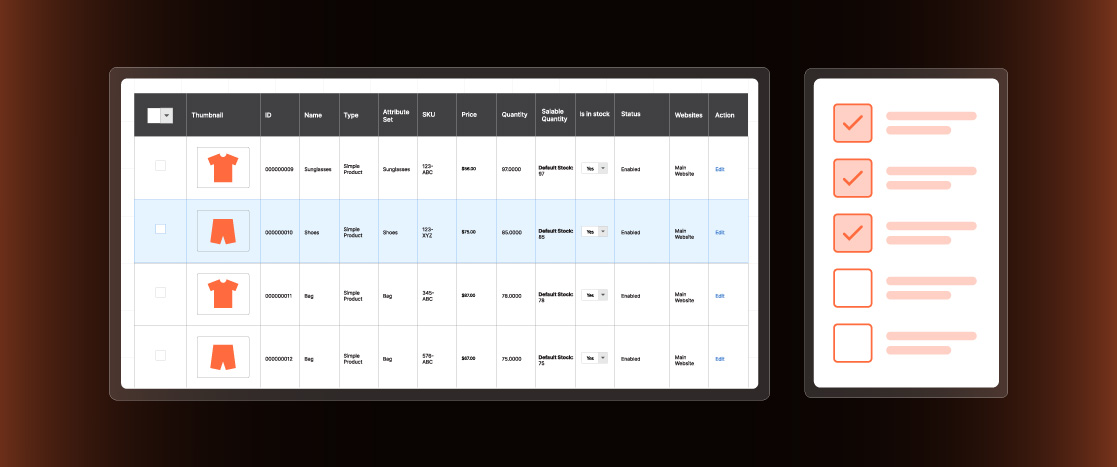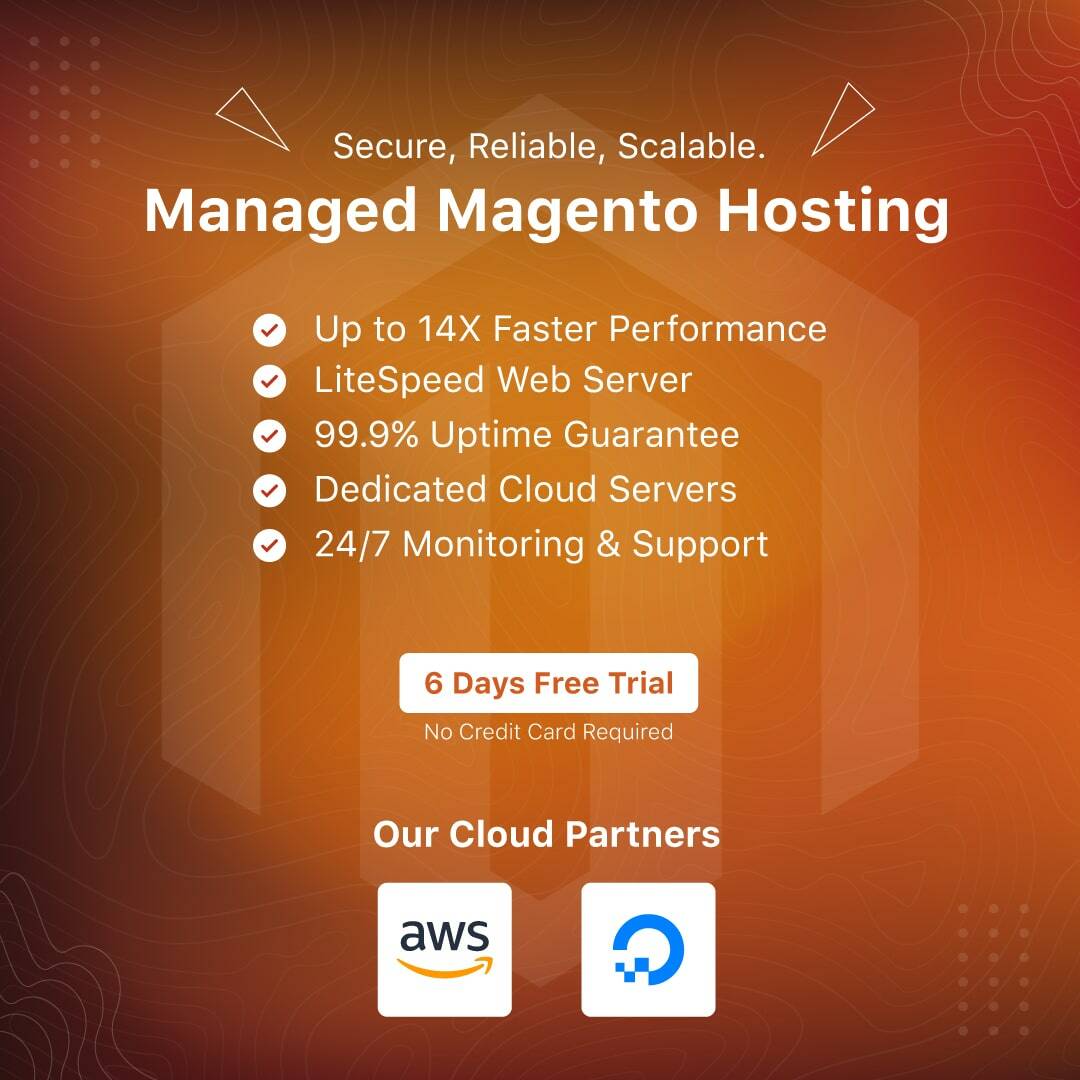
Which Magento Version Should You Choose and Why?
- Introduction
- Magento Versions History
- System Requirements for Magento 2
- Magento Installation
- Pros and Cons of Magento 2
- CMS Performance Requirements
- CMS Quality Attributes
- Usability of Magento
- Magento 1 Vs. Magento 2 Checkout Process
- Maintainability
- Frequently Ask Questions
- Expert Opinion
- Wrapping up!
- Introduction
- Magento Versions History
- System Requirements for Magento 2
- Magento Installation
- Pros and Cons of Magento 2
- CMS Performance Requirements
- CMS Quality Attributes
- Usability of Magento
- Magento 1 Vs. Magento 2 Checkout Process
- Maintainability
- Frequently Ask Questions
- Expert Opinion
- Wrapping up!
Introduction
After COVID-19 Pandemic, the E-commerce industry all over the world has enormously evolved. Businesses that had never had an online presence are now getting digital. The retail industry is also going digital with eCommerce websites.
For many years, the choice of eCommerce website developers has been Magento (Magento Latest Version). Hence, the demand for Magento developers has drastically increased.
There has been a constant debate among Magento Developers about which Magneto Version to choose for building eCommerce websites in online forums and communities.
You must have read articles about Magento 1 vs Magento 2 previously, if you are looking to decide the best version for building eCommerce website. General recommendation is to choose the Magento Latest version to find better support.
This article will discuss Magento’s history, its versions, and their respective pros and cons in detail. Also, you will get to know about compatibility, reliability, availability, cost, and community support factors. Let’s look at key takeaways from this article:
Magento Versions History
Magento has a remarkable history of about 14 years. The upgraded versions contain bug fixes, features enhancements, and available updates.
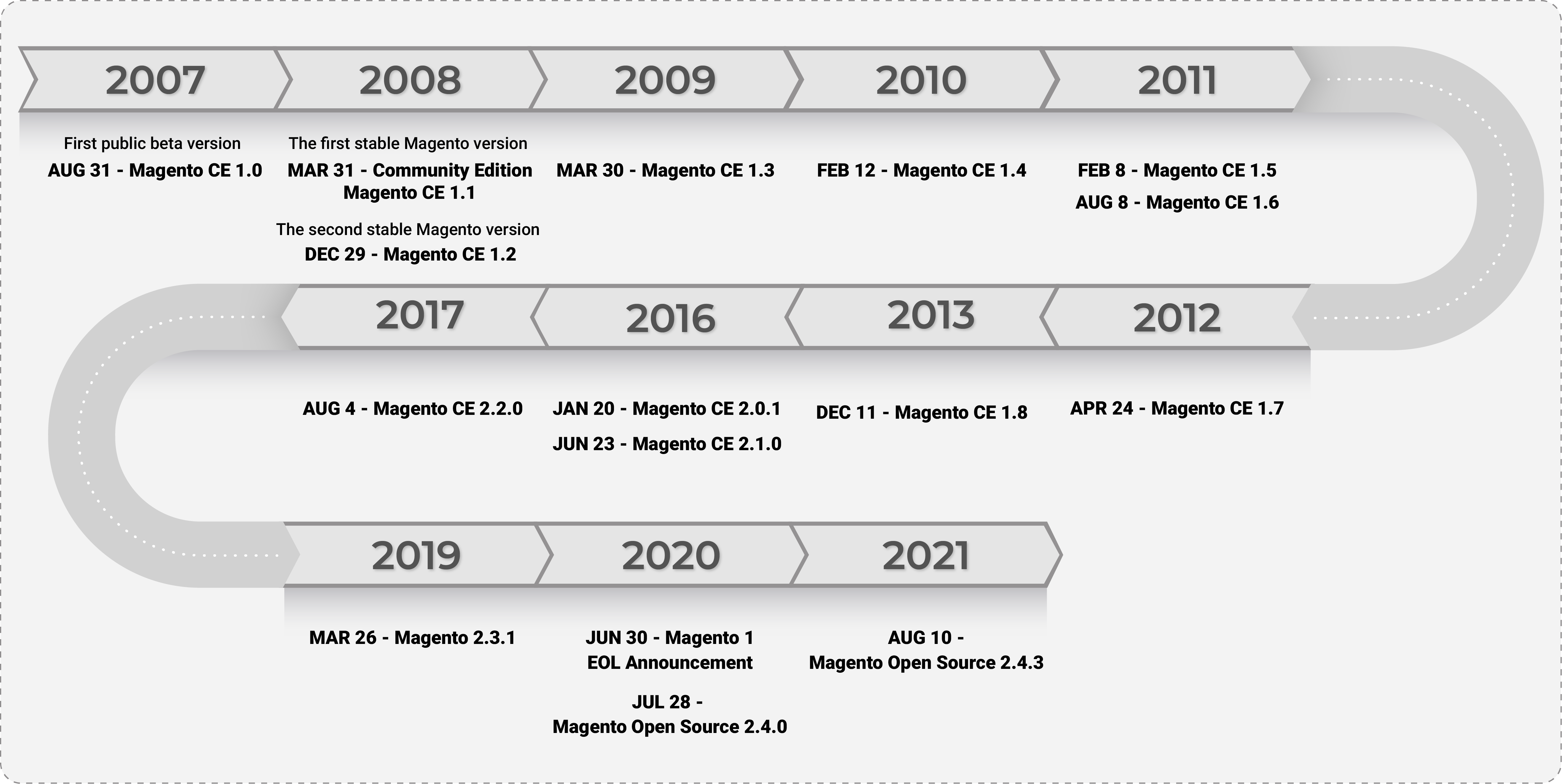
System Requirements for Magento 2
The below table shows the compatibility of Magento 2.x with other third-party software services and dependencies from the official Magento website. The Magento 2 only supports the below-mentioned third-party software service with their specific version, but all the software services are not mandatory for the development and hosting of Magento 2.
| 2.4.5 | 2.4.4 | 2.4.3-P2 | 2.4.3 | 2.4.2 | 2.4.1 | 2.4.0 | 2.3.7-P3 | 2.3.7 | 2.3.6 | 2.3.5 | 2.3.4 | 2.3.3 | 2.3.2 | 2.3.1 | 2.3.0 | |
| Composer | 2.x | 2.x | 1.x | 1.x | 1.x | 1.x | 1.x | 1.x | 2.x | 1.x | 1.x | 1.x | 1.x | 1.x | 1.x | 1.x |
| Elasticsearch | 7.17 | 7.16 | 7.16 | 7.1 | 7.9 | 7.7 | 7.6 | 7.16 | 7.9 | 7.7 | 7.6 | 5.x, 6.x | 5.x, 6.x | 5.x, 6.x | 5.x, 6.x | 2.x, 5.x |
| OpenSearch | 1.2 | 1.2 | 1.2 | – | – | – | – | 1.2 | – | – | – | – | – | – | – | – |
| MariaDB | 10.4 | 10.4 | 10.4 | 10.4 | 10.4 | 10.4 | 10.2, 10.3, 10.4 | 10.3 | 10.3 | 10.2 | 10.1, 10.2 | 10.1, 10.2 | 10.1, 10.2 | 10.1, 10.2 | 10.1, 10.2 | 10.1, 10.2 |
| MySQL | 8 | 8 | 8 | 8 | 8 | 8 | 5.7, 8.0 | 5.7 | 5.7 | 5.7 | 5.6, 5.7 | 5.6, 5.7 | 5.6, 5.7 | 5.6, 5.7 | 5.6, 5.7 | 5.6, 5.7 |
| PHP | 8.1 | 8.1 | 7.4 | 7.4 | 7.4 | 7.4 | 7.3, 7.4 | 7.4 | 7.4 | 7.3 | 7.2, 7.3 | 7.2, 7.3 | 7.1, 7.2, 7.3 | 7.1, 7.2 | 7.1, 7.2 | 7.1, 7.2 |
| RabbitMQ | 3.9 | 3.9 | 3.8 | 3.8 | 3.8 | 3.8 | 3.8 | 3.8 | 3.8 | 3.8 | 3.8 | 3.7, 3.8 | 2.x, 3.7 | 2.x, 3.7 | 2.x, 3.7 | 2.x, 3.7 |
| Redis | 6.2 | 6.2 | 6 | 6 | 6 | 5 | 5 | 6 | 6 | 5 | 5 | 5 | 5 | 5 | 5 | 5.x |
| Varnish | 7 | 7 | 6.5 | 6.5 | 6.4 | 6.2 | 6.x | 6.5 | 6.5 | 6.4 | 6.3 | 4.x, 5.x, 6.2 | 6.2 | 4.x, 5.x | 4.x, 5.x | 4.x, 5.x |
| Apache | 2.4 | 2.4 | 2.4 | 2.4 | 2.4 | 2.4 | 2.4 | 2.4 | 2.4 | 2.4 | 2.4 | 2.4 | 2.4 | 2.4 | 2.4 | 2.4 |
| Nginx | 1.8 | 1.8 | 1.8 | 1.8 | 1.8 | 1.8 | 1.8 | 1.8 | 1.8 | 1.8 | 1.8 | 1.8 | 1.8 | 1.8 | 1.8 | 1.8 |
PHP Extensions Requirements:
You must consider to get following extensions for Magento 2:
- ext-bcmath
- ext-ctype
- ext-curl
- ext-dom
- ext-gd
- ext-hash
- ext-iconv
- ext-intl
- ext-mbstring
- ext-openssl
- ext-pdo_mysql
- ext-simplexml
- ext-soap
- ext-xsl
- ext-zip
- lib-libxml
- ext-sockets (for Magento 2.4)
PHP OPcache:
You will need to authorise PHP OPcache for performance purposes.
PHP Settings:
You should check memory_limit to avoid memory limit problems using Magento 2.3.
SSL Requirements:
Magento 2 requires transport layer security TLS and a security certificate for HTTPs. It should be noted that Magento 2 does not support self-signed SSL certificates.
System Dependencies Requirements:
Following are the system dependencies requirements:
- bash
- gzip
- lsof
- MySQL
- mysqldump
- nice
- PHP
- sed
- Tar
Mail Server Requirements:
You need to fulfill the following requirements for a mail server:
- Mail Transfer Agent (MTA)
- SMTP server
Browsers Requirements:
Magento 2 has the following browser requirements:
- Safari Mobile
- Safari and the previous version (for Mac OS)
- Microsoft Edge latest and the previous version
- Firefox latest and the previous version.
- Chrome latest and the previous version
- IE 11 or later (Till Magento 2.3)
Magento Installation
The installation and optimization of software services for Magento 2 development or hosting required an expert level of skills and time. The basic installation steps of Magento 2 are mentioned in the below diagram.
Don’t worry about the installation setup because the Devrims platform provides One-Click installation Magento 2 on a dedicated cloud server with optimization and high performance.
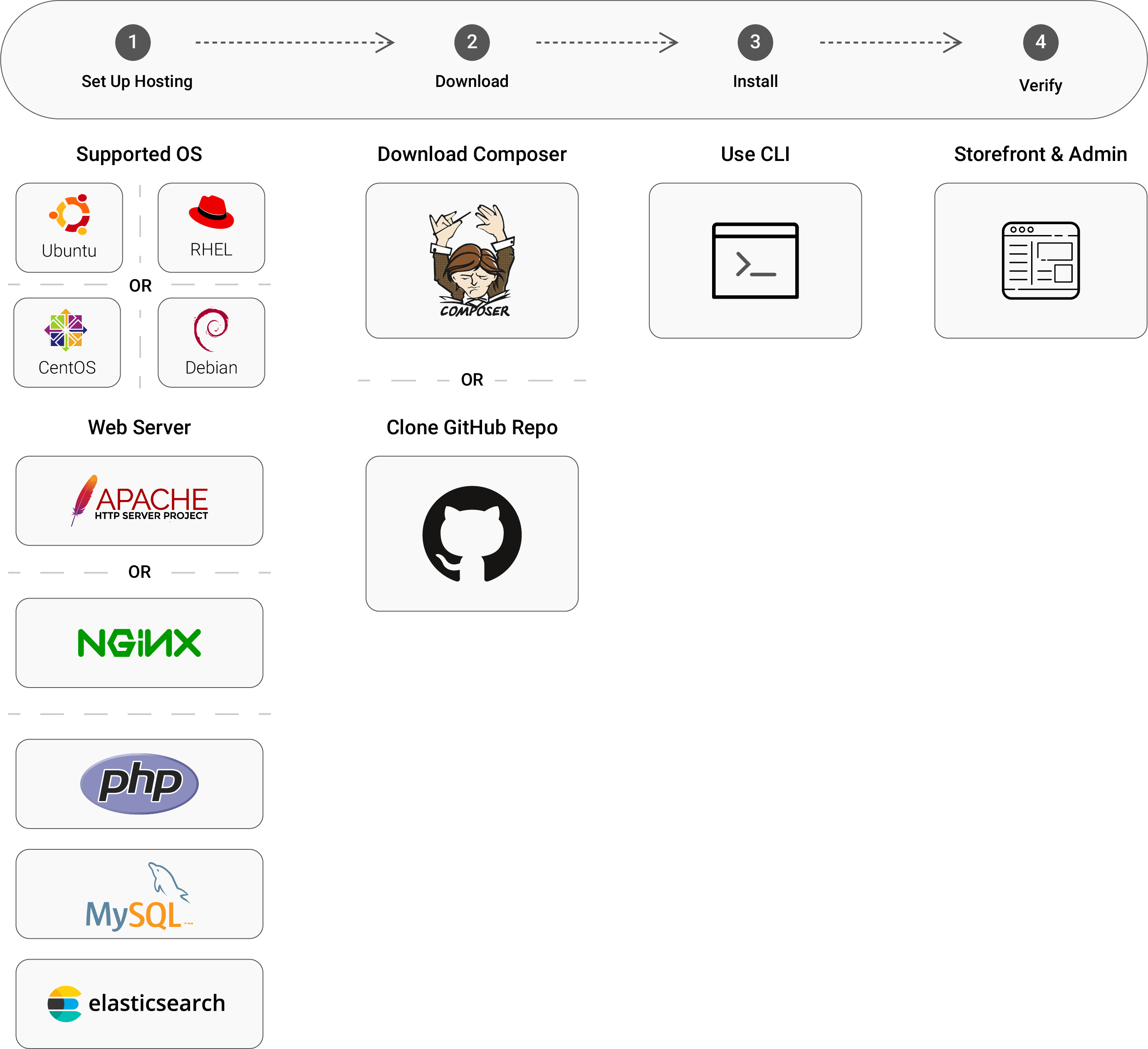
Pros and Cons of Magento 2
The eCommerce industry has evolved with new technologies in the last few years. Things have come upon you at the tips of your fingers. So you may even order groceries through mobile apps.
First of all, Magento is an open-source platform. Magento has been one of the top-rated eCommerce site-building content management systems. On the contrary, it has a few disadvantages as well.
Now, we will discuss the advantages and disadvantages of Magento 2.
Pros of Magento
1. Flexibility:
We may modify the source code of Magento as per the requirements. It may allow customization of templates to build an e-store.
Magento is flexible enough to allow third-party integrations, such as product imports, for different purposes.
It helps in analyzing the performance of websites with real-time data.
2. Unique Features:
Magento offers a wide range of features for managing multiple stores, languages, currencies, pricing, third-party payment gateways and locations.
Magento provides an option to change the price of a product according to the group of customers. You may fix prices for staff and VIPs differently. In addition to this, the community version of Magento is enriched with distinct features, which are not provided by every eCommerce platform.
3. Community Support:
The Magento community is supportive as it has been the first choice of eCommerce developers for a long time. Moreover, the community has added useful plugins and extensions to Magento Library. So, if you encounter any issue on your eCommerce site built with Magento, you are likely to get guidance quickly.
4. Mobile Friendliness:
The success of an eCommerce website is also dependent upon mobile friendliness. Online e-store owners can’t neglect that the internet browsing trend is shifted to mobile devices.
Magento provides opportunities to develop a site and provides a friendly mobile experience to customers. Hence, it ultimately helps in increasing sales and decreasing bounce rates.
5. Scalability:
Most eCommerce businesses start small and gradually grow. But all the eCommerce cms platforms are not efficient enough to bear the change of increased sales. Luckily, Magento is capable of adapting to change without affecting the website.
Magento can support up to 500000 products and transactions in an hour. In this way, you may customize the Magento store without any limitations.
Cons of Magento
1. Cost:
As discussed earlier, Magento has released many versions since the beginning. Magento has a free version, but the enterprise version asks you about 15k dollars.
If you are not comfortable integrating an extension, you may add a third party with a fee. Therefore, it is a disadvantage of this utterly perfect eCommerce platform.
2. Less Availability of Developers:
Magento has a large online community, but professional developers are insufficient to meet the current development requirements.
The top reason behind it is the complex object-oriented programming architecture.
Magento contains more than 20 thousand files and nearly 200 database tables. Hence, it needs plenty of time to master its architecture. On the other side, professional developers demand high wages, so all startups can’t afford them.
3. Speed:
A common issue with Magento is a slow load time. Hence, it takes a long time to customize compared to other eCommerce platforms. Also, migration from other eCommerce platforms to Magento is comparatively tricky due to the slow data transfer rate.
The slow loading rate is due to architecture flexibility that makes it time-consuming and complex. On the contrary, enterprise and premium versions are fast.
Many hosting providers like Devrims design their platform to provide high-speed Magento Hosting even if you are using Magento free version with the help of caching, services optimization, better hosting architecture etc.
4. Hosting:
Experts suggest using a dedicated server Magento hosting for stores. Also, It should be hosted on a server on which the developer has sufficient proficiency.
Devrims Managed Magento Hosting makes it easy for you. Now host your Magento store in clicks without worrying about the hosting server and website migration. Our platform automatically configures and optimizes your Magento store and our support team will migrate your application with performance enhancement.
5. Less Product Support:
Magento product support is costly because developers charge heavily. The official Magento forum is not very helpful in product support.
You can imagine if you have your e-store, which encounters a problem with limitation of support and it results in high cost.
For a complete breakdown of Magento expenses, check our guide on Magento Development Cost.
CMS Performance Requirements
1. Caching:
Many Magento site owners complain about caching issues. Few of the problems are easy, whereas developers should debug a few problems carefully. Research suggests that it happens due to not uncacheable blocks inside the page. If you have not added every page to the cache, uncashable globally defined blocks will disable the entire page cache system. Hence to fix caching issues, you will have to find incorrect uncacheable blocks and either remove or fix them.
2. Speed:
As discussed earlier, many Magento-based site owners complain about slow speed issues. To avoid or eliminate these issues, we suggest choosing a fast hosting service like Devrims. Secondly, ensure that production mode, CSS/ JS minification, and full-page cache are enabled, and inspection of 3rd party extensions is done. Also, it is recommended not to use JS bundling. For caching, we suggest using a built-in cache and skip varnish.
3. Architecture:
Magento is developed by the Zend framework. Zend has an object-oriented library of code which makes Magento a reputable project. Hence, Magento was developed by keeping three things in mind:
a) Flexibility:
Magento code is customizable. It could be easily customized to suit the theme style you have chosen.
b) Upgradeable:
Magento can be customized by separating code from the community and local customizations. It does so without listing the ability to upgrade.
c) Security:
Security is the most important and should be part and parcel of any online store. As a business owner, you know it’s the biggest risk of your online existence and reputation.
Ecommerce CMS like Magento is always a favorite choice of many big online brands and this fact makes Magento a golden opportunity for attackers.
Magento has created the CMS with many advanced security features on architecture lever and offers a wide range of security options for stores owner and visitors like advance password management, flexible file permissions and ownership on the server-side, regular security updates, SSL certificate requirement for secure communication between host machine and browser, secure payment gateways integration options, improved cross-site scripting (XSS) prevention, option to change default admin URL and many more.
Apart from the default security features, you can apply 2FA, regular website backups, WAF, and firewalls to make it more secure.
CMS Quality Attributes
1. Themes Availability:
You may find mobile-friendly themes online for your Magento store from Magento marketplace or ThemeForest. You may choose the theme, whichever style suits your style. If you want a free Magento theme for your online, please read this article.
2. Plugins and Extensions:
Magento has many plugins and extensions like customer support, marketing, finance, shipment, site optimization, etc.
3. Payment Gateways:
When you explore payment gateways for your Magento store, you should consider PCI chameleon payment gateway, cost, supported countries and currencies, types of credit cards, cart compatibility, fraud screening tools, virtual terminals hosted, and last but not least, customer support.
Paypal, Braintree, Stripe, authorize.net, amazon Payments, 2checkout, CyberSource, Skrill, Amazon Pay, and Klama are some of the names supported by Magento.
Usability of Magento
The dashboard is the most crucial window for user interaction with any content management system; let’s have a quick look at the Magento dashboard:
1. Dashboard:
The dashboard is the first interactive window when you log in to the admin. You may get real-time insights into sales and customers’ behavior, including lifetime sales, recent orders, search terms, and average order amount.
Moreover, you may view short reports about the most viewed products, new customers, and best-selling products on the bottom tabs. Let’s suppose you have a large amount of data. Then you may turn off the chart for better performance.
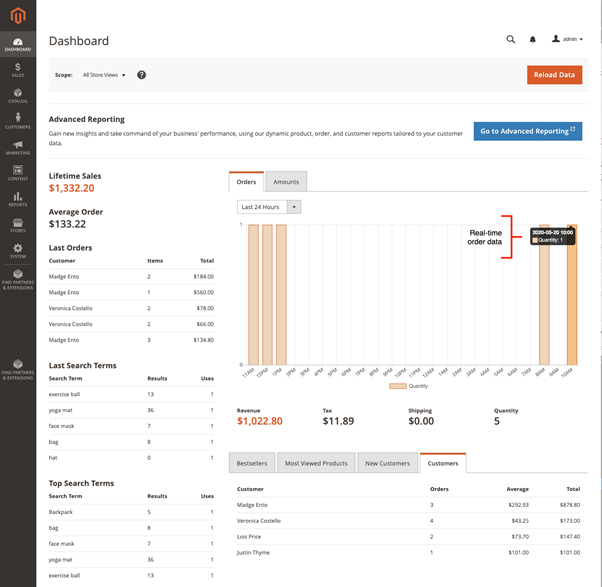
You may view a personalised dashboard based upon order, customer data, and the product.
2. Advanced Reporting:
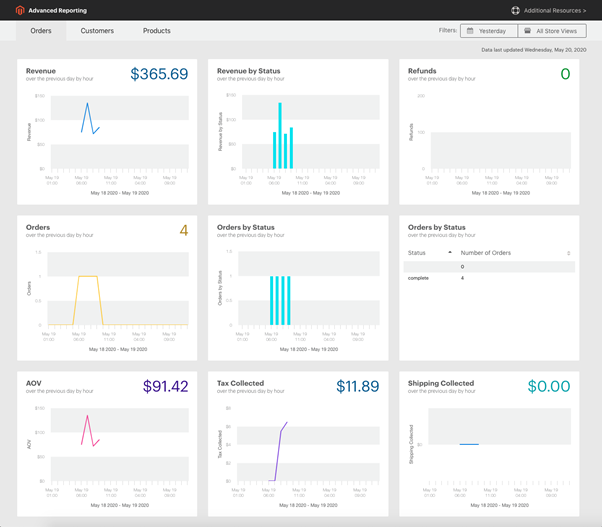
a) Dashboard Configuration:
On the Admin sidebar, go to Stores > Settings > Configuration and follow these steps:
- At the time when the configuration is complete, click Save Config.
- Save changes, click Cache Management, and refresh every invalid cache.
b) Enabling Charts:
As mentioned earlier, you may turn off the charts if you have extensive data to process. A message “No Data Found” is displayed along with the summary. To enable charts, use the following settings:
- Select admin under Advanced in the left side panel.
- Expand Dashboard section, if required.
- For changing default values, use a system value checkbox.
- Put enable Charts to Yes

c) Startup page:
The dashboard shows the default startup page for Admin, but you may configure an entirely different startup page:
Navigate to the Advanced > Admin section and expand the Startup Page section.
Reset use the system value checkbox and select the startup page you want to show in the Admin.

d) Data Source configuration:
Dashboard charts can be produced in real-time with the help of aggregated data. To enhance performance and fasten with aggregated data, the following steps should be followed:
- Expand sales and select sales in the left panel.
- In Dashboard, just reset use system value checkbox and choose to use aggregated data to anyone from the following:
- For Real-time data, select No.
- For historical data, choose No.

Chart Sections (showing Orders, Amounts, Time range and summary total, Snapshot data (Lifetime sales, average order, Last order, last search terms, top search terms), Report tabs (Bestsellers, Most viewed products, New customers, customers), Dashboard buttons (Reload data, Go to advanced reporting).
3. Mobile-friendliness of Magento 2:
Magento 2 is designed to be responsive irrespective of the device on which it’s being opened. UI automatically adjusts to screen size, whereas themes are adjustable to available sizes and resolutions. Themes of Magento add additional mobile features on mobile devices. Magento 2 also plays a part in getting a better ranking in search engines as Google announced to index the mobile site version first.
Magento 2 is a mobile-friendly CMS as it provides a well-optimised mobile API. It supports java developers of various skill levels. Hence, creating a mobile app with the new API is more than manageable.
Magento 2 provides an excellent UI for building an excellent E-store and provides a wide variety of apps, functions, and extensions that could be easily added to your business.
On the other hand, Magento 1 got a lot of complaints regarding mobile responsiveness. Therefore, the need for an upgraded version of Magento arose. The release of Magento 2 took the marketing to the next level and facilitated thousands of entrepreneurs to optimise their websites.
4. Ease of development in Magento 2:
Magento 2 provides ease of development with respect to different parameters which are discussed below:
a) Multi-site Management:
There have been general reviews of Magento that its development is costly due to high demand and lack of availability of Magento developers. However, Magento’s development has a positive side too. It offers a multi-store option which makes it a preferred choice for many eCommerce business vendors. Also, it allows online shop management from a single dashboard. You may even add products to multiple stores.
b) Open-Source Platform:
Being an open-source CMS keeps a plus point against the competitor Shopify where you need to pay for the system. Magento developers usually promote Magento stores by Magento modules. Hence, by developing Magento modules on an online store, a developer may add new features for an impressive look.
c) 3rd Party Integrations:
With Magento, you may integrate a significant number of third-party services on your website. It includes payment gateways, transportation, database applications, order tracking, shipping, and so on.
d) Checkout Page:
Magento 2 checkout page loads more javascript code than any other page. But still, it’s the checkout page is the most important page for converting customers. In Magento 2, you can easily optimize the checkout page as your data and design requirements for a high conversion rate.
Magento 1 Vs. Magento 2 Checkout Process
Magento 2 came with a lot of advancements overall but it made the checkout process from a six-step to 2 step process:
a) Magento 1:
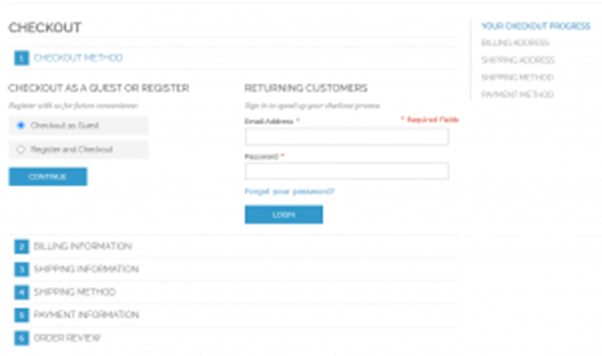
b) Magento 2:
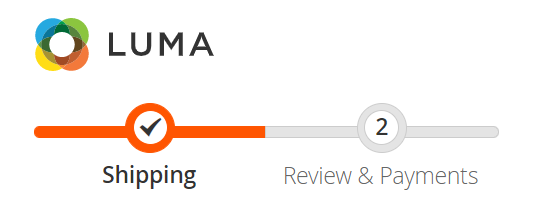
Magento 2 checkout process automatically looks for existing customers. Additionally, order process improvement and the implementation of well-known payment gateways make it the perfect choice for eCommerce businesses.
Magento 2 checkout may handle 117% more orders per hour than Magento 1. Also, M2 can handle 2 million catalog views per hour.
Hence, the M2 checkout process is user-friendly and faster than the M1 Checkout process.
In M2, you experience a reduced cart abandonment rate and access to a few modern features like strengthened SEO capabilities, various payment gateway features, and extended search capabilities.
Maintainability
We suggest following standard programming best practices to avoid bugs and improve extensions’ maintainability for Magento store maintenance.
Let’s have a quick overview to maintain best practices better:
1. Follow coding standards:
Follow best coding practices so that another developer may debug the code later.
2. Write reusable code:
We suggest avoiding writing duplicate code. You should create a single class or method and reference it whenever needed.
The code you produce should be focused, small and generic, and reusable.
3. Design replaceable code:
Designing replaceable code has the same significance as making it reusable. Reusable means code is modular and loosely coupled, making it easy to improve for updates.
4. Avoid Helper Classes Creation:
Helper classes are filled with static methods. These classes usually are against the common principles of object-oriented programming. Users should avoid Helper class functions because they attempt to solve a single class.
5. Naming Conventions:
Naming conventions should be uniform and understandable through the core. It includes files, folder names, classes, and methods.
6. Avoid Around Plugins:
Around the method, plugins increase stack traces and affect performance. You should avoid their use. Their use is legitimate when you need to terminate the execution of all other plugins and methods.
7. Code Testing:
Testing code is essential to see how it works under various conditions and also helps in defining functionality. Hence, it is recommended to write testable code and follow the Magento testing guide to create tests for the code. Also, the check test covers a variety of conditions to avoid bugs when the code is edited.
Frequently Ask Questions
There are few common frequently asked questions about Magento versions. Let’s have a quick answer to all of these.
Why is Magento 2 better than Magento 1?
M2 is better than M1 in many ways, including features, mobiles, friendliness, SEO, etc. The official product support has ended for Magento 1. M1 has a lot of extension conflicts as well. Also, M2 provides more security than M1. So, M2 is better than M1.
What is the difference between Magento 1 and Magento 2?
The core difference in M1 and M2 concerns PHP, PSR, HTML5, CSS3, JQuery, RequireJS, Nginx, MySQL, Gulp, Twig.
How do I know what version of Magento I am using?
Following methods allow you to check your website’s Magento version:
- Check Admin Dashboard
- Check Composer.json file
- Check Composer.lock file
- Check via Command Line
- Using the Chrome Extension
- Check from the URL
- Check PHP Code
- Using Online Tools
Is Magento better than Shopify?
Based upon reviews, Shopify is better than Magento, but it has a cost drawback. Shopify is paid, whereas Magento’s basic version is free.
Expert Opinion
We asked “which Magento version” should you choose at various platforms and got exciting replies. A few of them are as follows:
Kimberley Thomas, practice lead at Magento services, says she likes the most recent version.

Whereas Ashley Schoder, a software developer and creator of a2xaccounting.com, says version 1.9 is his favourite.

What is the different edition of Magento?
Magento has two versions of its platform: Magento community edition, which is a free open source version, and Magento Enterprise edition, which is a paid premium version that gives businesses access to all of Magento’s features.
Wrapping up!
There is no qualm that M2 is better than M1. M1 is outdated and lacks even product support, community support, payment gateways support, etc. So if you want to run your eCommerce website smoothly, you should build your website on Magento 2.
Devrims provide Fully Managed Magento Hosting on dedicated cloud servers of industry-leading infrastructure providers: Amazon Web Service and DigitalOcean with a one-click server-level caching option. We free website migration with performance enhancement, so try Devrims hosting platform via creating Free Six Days Trial Account.
Share your views in the comments section below the experiences of your Magento website.
